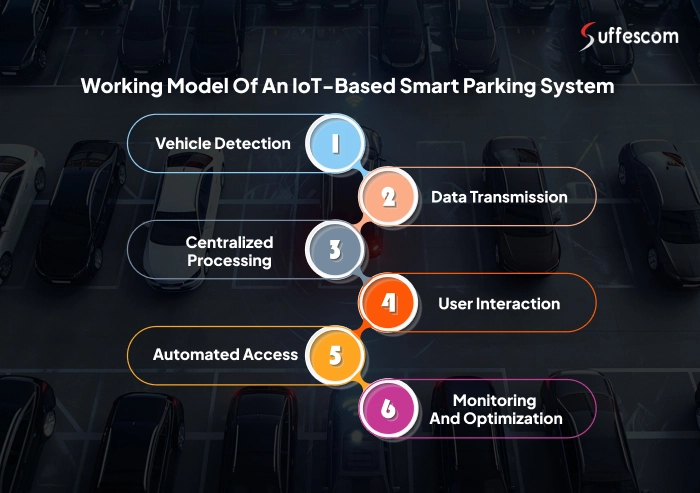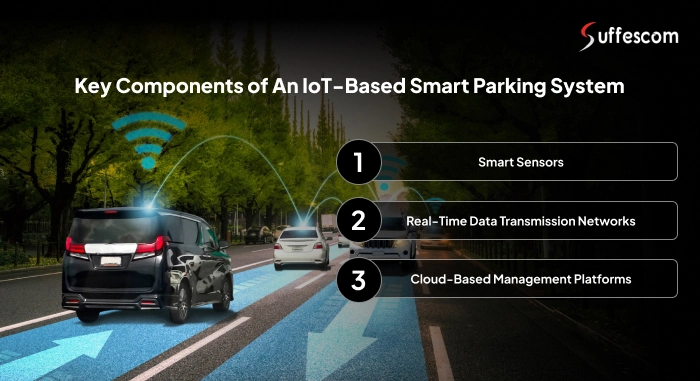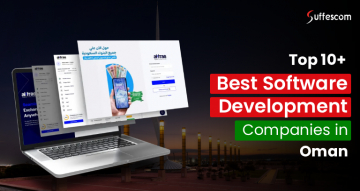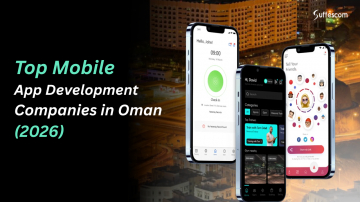How IoT is Resolving The Persistent Urban Parking Challenges?

With the rising number of vehicles, urban parking is becoming a pressing issue. Jam-packed roads and full-to-the-brim parking spaces leave us no choice but to think about solving this problem before it gets out of hand.
Certain authorities are doing their bit to tackle this challenge. IoT developers have a significant role to play when it comes to managing urban parking spaces for higher accessibility and ease of operations.
How Serious is the Concern?
Urban parking problems are a significant concern that affects many people in various ways. They make life more complicated for everyday drivers, hurt local businesses, put pressure on city officials, and take a toll on the environment.
These challenges don't just cause frustration; they impact how cities work and how people feel living in them.
- The daily struggle to find vacant parking spots can increase stress and anxiety among urban citizens.
- Areas with severe parking shortages have a direct impact on sales for shop owners and local businesses.
- Delivery vehicles frequently face delays due to a lack of last-mile parking, disrupting commercial activity and supply chains.
- Approximately 30% of all city land is dedicated to parking, often at the expense of housing, commerce, or green spaces.
- Longer search times for parking can elevate urban pollution levels and greenhouse gas emissions, thereby worsening air quality.
Urban parking problems are not only a nuisance but also a critical economic and social issue. These problems are resulting in measurable losses and damages for residents, businesses, and governments.
How IoT is Working Towards Solving Various Urban Parking Challenges?
Let's understand the various urban parking challenges and how IoT is helping to solve them.
1. Searching for Parking
Various studies indicate that 30% of the traffic in urban cities is caused by drivers searching for parking spots, resulting in time and productivity losses.
How does IoT help to tackle this problem? The IoT systems utilize sensors to monitor parking space occupancy in real-time. It allows drivers to instantly locate available parking spots via mobile apps or digital signs.
By quickly identifying a free parking space, it gets easier to reduce the time vehicles spend on roads searching for parking. Ultimately, it reduces congestion and carbon emissions.
2. Underutilization of Parking Spaces
Conventional parking management systems are inefficient in managing parking spaces. Inefficient utilization often results in overcrowding specific areas, while underutilizing the others.
IoT-enabled applications are capable of collecting and analyzing data on parking usage and trends. With such data, concerned authorities can;
- Optimize parking allocation
- Implement dynamic pricing, and
- Forecast demand
These three initiatives proved to be a catalyst for improving efficiency, better space utilization, and resource planning.
3. Environmental Impact
Our environment has to pay a heavier price due to the prolonged search for parking and misutilization of parking spaces. As a result, we breathe in polluted air.
IoT technology seems to have a solution for this problem as well. As IoT systems help reduce the time and distance that vehicles spend searching for a parking spot, they gradually decrease fuel consumption and gas emissions.
4. Poor User Experience
Traditional parking management systems did not focus on the user experience. Manual payment systems often frustrate citizens and lead to inefficient city revenue collection.
As IoT automates payments, reservations, and provides real-time updates, it enhances the user experience and ensures transparent and error-free revenue collection.
5. Security and Safety Concerns
Traditional parking lots are not entirely safe for the vehicles. People often face issues such as theft, unauthorized use, and inadequate monitoring. More than financial loss, it creates mistrust among citizens in governmental authorities, which is not an ideal situation.
6. Lack of Data for Urban Planning
Data is essential to improve anything, from a process to a product. Urban planning is one sphere where accurate and consistent data is absent. City planners lack comprehensive data to optimize parking policies and urban development.
This is where IoT comes into play, providing standardized data. IoT applications, when integrated with a parking system, deliver dedicated dashboards for real-time data. Using such data, stakeholders can make informed decisions on infrastructure investments, traffic routing, and future parking needs.
Revolutionize the Urban Parking Spaces
Be the first mover and make the passengers' commute a lot easier. Invest in an IoT-powered smart parking system now.
How is IoT Transforming The Parking Business System?
IoT is delivering everything that technology is expected of, from simplifying operations to increasing accessibility. Let's explore how IoT systems can help governments, urban planners, and municipal corporations to tackle the complex web of urban parking and improve it.
IoT is Helping Develop New Business Models
IoT systems also ensure that their implementers generate significant returns. IoT enables diversification of revenue streams, including both primary sources and secondary opportunities, listed below;
Primary Sources of Revenue
1. SaaS Subscriptions: IoT-powered smart parking systems ensure recurring monthly/annual fees for platform access and features.
2. Hardware Sales: It includes one-time fees for using IoT sensors, smart meters, and gateway devices. It is like selling a commodity at its retail price.
3. Transaction Fees: Application owners can charge a specific percentage of the digital parking payment fee.
4. Data Analytics Services: There is another option than selling the software, its services, or its hardware components. The owner can sell the premium insights and reporting for enterprise clients.
Secondary Sources of Revenue
1. Dynamic Pricing: Owners can charge higher, leveraging the rising demand with AI-driven pricing optimization.
2. Space Rental Programs: Monetizing underutilized spaces during off-peak hours.
3. Premium Services: VIP parking, EV charging integration, or valet services for a higher user experience.
4. Advertising Revenue: Advertising for non-competitor business entities would generate higher revenues through digital signage and location-based marketing.
IoT Helps Cut Operational Costs
Implementing IoT-based smart parking solutions helps the parking owners, real estate managers, or other concerned authorities to save on;
1. Labor cost: As human staff won't be required for manual operations.
2. Energy resources: Features such as smart lighting and ventilation systems reduce electricity costs.
3. Maintenance costs: Equipment downtime reduces with the help of predictive maintenance.
4. Penalties and fines: Automated compliance monitoring.
Efficient Urban Planning with Analytics
Data analytics and predictive intelligence play a crucial role in enhancing urban planning.
IoT-powered smart parking systems aid in generating valuable data insights for smart decision-making.
Let's understand how the three pillars of IoT-enabled systems help improve urban parking.
Operational Analytics
The foremost function of IoT smart parking systems is to improve the daily and constant parking operations by delivering the following features-
- Space utilization patterns across different time periods
- Peak demand forecasting
- Capacity planning
- Revenue optimization through various pricing strategies
- Customer behavior analysis
Predictive Modelling
IoT systems for parking management incorporate models that predict outcomes based on historical data to improve urban parking spaces with the following-
- Machine learning algorithms to predict future parking demand
- Weather-based occupancy adjustments
- Event-driven capacity management
- Maintenance scheduling optimization
Business Intelligence
Business intelligence is essential for businesses owning or managing the smart parking spaces using-
- Custom dashboards for different stakeholder groups
- Automated reporting
- Real-time alert systems
- Integration with city planning and traffic management systems
- Environmental impact monitoring and reporting
Assurance of Higher User Experience
Nothing beats a better user experience, and a poor one is one of the leading factors behind a significant drop in parking system users. IoT-powered smart parking systems, especially when integrated with mobile devices, bridge this gap between users' expectations and delivery.
Modern IoT urban parking systems provide comprehensive mobile experiences.
Core and Advanced Features Play a Major Role
An IoT-enabled parking system is inefficient without its core features. The following core features improve the process efficiency and set a path to tackle urban parking challenges;
- Real-time parking availability
- Interactive maps
- Advanced booking and reservation provisions
- Multiple payment options, including digital wallets
- Real-time navigation to reserved spots
- Automated session extensions
- Parking history
- Receipt management
These core features can help streamline the urban parking challenges, but it is extremely important to get advanced. The following advanced capabilities of IoT-based smart parking systems ensure the same.
1. AI-powered parking recommendations: With AI's potential, the drivers or parking managers can reduce the search time for finding a vacant spot. It becomes easier to optimally utilize the space, reduce pollution, and above all, enhance the user experience.
2. Integration with calendar and navigation apps: It gets easier to synchronize and coordinate parking reservations by integrating the parking system with calendar and navigation apps. Drivers get guidance from their current location to their exact parking spot, reducing traffic congestion and improving user experience.
3. Loyalty programs and discount systems: If certain features are available in the parking management systems, then they are likely to be widely adopted. Users always need an intrinsic motivation to use an application, and loyalty and discount programs help achieve this.
4. Multi-language support and accessibility features: More often, tourists or foreigners need language support. Hence, the multiple-language support lets users find vacant spots smoothly. It boosts accessibility and user satisfaction.
Seamless Payment Systems
Often, users find it extremely complex and tiring to pay using the traditional payment systems; they have to wait for the machine to print out the receipts and move along. In this short period, the waiting queue gets longer in the snap of a finger!
IoT enables frictionless payments by:
- Enabling contactless entry/exit by recognizing the license plates
- Processing bills automatically as per the actual usage time
- Integrating the parking systems with FASTag, RFID, and mobile wallets
- Presenting dynamic pricing displays and transparent fee structures
Working Model of an IoT-Based Smart Parking System
It has been established that an IoT-powered smart parking system is improving the urban parking landscape. How do these tech wonders work? Let's find out. Here's a step-by-step workflow;

1. Vehicle Detection
The workflow of an IoT-powered smart parking system starts as it detects a vehicle approaching the parking space. Sensors initiate the process by continuously monitoring each parking spot, whether it is occupied or vacant.
In addition to detecting vehicles, these sensors also monitor environmental factors for safety and maintenance.
2. Data Transmission
Every sensor reports a change in the status using wireless protocols such as LoRaWAN, NB-IoT, or WiFi to a nearby gateway. Furthermore, this gateway transfers data to the cloud in real-time. Quick data transmission enables;
- Real-time information transmission
- Quick operations
- Cost savings
- Smart decision-making
- Higher operational efficiency
3. Centralized Processing
After centralizing the data, the smart parking system will now process it. The in-built cloud systems receive and process incoming data, update dashboards, and perform analytics to forecast demand and detect patterns.
Though IoT-powered smart parking systems can perform other advanced functions promptly and in real-time, it all depends on the user's input.
4. User Interaction
It is time to interact with users and reply with relevant and authentic information. The system sends the data back to the drivers, allowing them to access real-time parking availability through a mobile app, web portal, or digital signage.
IoT parking applications also guide users to vacant spots and facilitate reservations or payments.
5. Automated Access
As soon as the information is provided to the users, the entry/exit barriers open automatically when a parking space is reserved for a registered vehicle (recognized via license plate or RFID sensor), making the process seamless and contactless.
6. Monitoring and Optimization
Such parking systems automatically monitor the occupancy to reduce congestion and improve traffic flow, saving time and costs for passengers and parking space owners. Upon instructions by the operators, these software can-
- Apply dynamic pricing
- Handle enforcement, and
- Analyze trends for continuous improvement
The Key Features of IoT-Powered Smart Parking System
There is a specific set of essential and advanced features (briefly mentioned in the section just above the working model) that aid in establishing and streamlining the urban parking space. Let’s understand the features!
a. Basic and Essential Features
These features are a must-have in an IoT-powered smart parking system.
1. Real-Time Parking Occupancy Detection
Sensors, including ultrasonic, infrared, and magnetic, are the prime component responsible for detecting vacant parking spots in real-time. These are installed in each parking space to detect whether a spot is free or occupied.
Such sensors collect data and transfer it quickly to a centralized platform to update the digital sign boards and user applications. Quick information exchange allows drivers to view vacant space availability in real-time, reduce search times, congestion, and carbon emissions.
2. Mobile App
A mobile app ensures users have access to information and services for bookings, navigation, and instant payments. A seamless mobile application increases user convenience, improves spatial planning, and reduces dependencies on manual tasks.
Real-time app integration can reduce the time spent searching for parking by almost half.
3. Digital Payment Integration
Once payment gateways are connected with parking meters and mobile apps, the smart parking systems ensure secure, cashless transactions. The drivers can easily pay within the app or at the kiosks with a card, e-wallet, or other payment platforms.
Integrating digital payment gateways and platforms with parking systems helps remove queues, improves cash management, and simplifies the ticketing process.
4. Automated Access Control
The number of tools, such as ANPR, RFID, or NFC, helps automate access control, ensuring hands-free entry/exit and security. Using these automated access controls, these components automatically open the barriers for registered vehicles while simultaneously logging and flagging the unauthorized entries.
These features help improve the parking lot's security, speed up entry/exit, and enable contactless operation. RFID/ANPR systems in Europe have systematically reduced unauthorized parking and improved flow in urban garages.
5. Centralized Cloud-Based Management
A centralized cloud-based system gathers data from all the sensors (as explained in the operational process above as well). This data helps with analysis, reporting, and system optimization through the cloud.
The result generated from a centralized cloud system helps operators monitor occupancy, revenue, and other essential metrics using dashboards. It is an essential feature for the parking space owners as it greatly helps to scale from a single parking lot to a widespread network.
An established company understood this and effectively utilized the potential-
Smart Parking, a global smart parking management solution, used Google Cloud to cut operational support costs by over 50% while deploying more than 50,000 sensors.
6. Loyalty Programs and Discount Systems
Since user retention is highly crucial for a software to succeed in this cut-throat digital market, incorporating loyalty and discount systems becomes essential. Digital loyalty programs offer points, discounts, or perks to repeat parkers or app users.
Such enticing offers boost user retention and fill spaces during low-demand periods.
b. Advanced Features
These features make IoT-based smart parking systems highly functional and resilient to technological changes.
1. AI-Powered Parking Recommendations
AI algorithms analyze traffic, historical demand, user profiles, and real-time conditions to recommend optimal parking spots. With AI-enabled recommendations, the drivers get personalized space suggestions, considering route, duration, events, and preferences.
AI-enabled technology automates everything, from finding the right spot to keeping the parking lot accessible 24/7. When integrated with predictive analytics, an AI-enabled parking system helps reduce greenhouse gas emissions.
2. Integration with Apps
Two major apps, Calendar and Navigation, are essential to integrate with IoT-powered parking systems. The platforms that are in sync with digital calendars and navigation tools help improve planning.
Such an integration is beneficial for ensuring adequate parking spaces during key events/trips to streamline the entire urban journey.
3. Dynamic Pricing
When powered by IoT, these systems adjust prices in real-time based on location, demand, time, and other key factors. Increasing prices during peak times, providing discounts during low traffic, and special rates for events and loyal members not only ensures constant revenue but also significantly solves the urban parking challenges.
IoT systems also help balance demand, enhance utilization, and improve user experience.
4. Smart Signage and Voice Guidance
LED displays and audio systems direct users to open spaces or accessible zones. Smart signage and voice guidance make a parking lot accessible for visually impaired citizens. Along with increasing accessibility, it reduces congestion and prevents illegal parking.
5. Environmental and Safety Monitoring
Integrating environmental sensors and surveillance systems with parking systems delivers functions such as;
- Alerts for high pollution or fire risk
- Video-based analytics for suspicious activity
- Enforcing initiatives quickly
Environmental and safety monitoring improves user safety, the parking facility's health, and air quality. IoT-based parking systems reduce vehicle emissions by up to 40% in high-traffic cities.
IoT-Powered Smart Parking System Development: A Complete Guide
This section is beneficial for individuals or organizations willing to invest in IoT-powered smart parking systems. The following three components help understand everything essential;
What is the Cost of an IoT-Powered Smart Parking System?
A fully functional and market-ready IoT-powered smart parking software costs between $15,000 and $40,000. This range varies in consideration of multiple factors such as;
1. Integration complexities with app infrastructure and third-party systems.
2. Implementation of advanced features like AI-driven dynamic pricing, environmental monitoring, and advanced safety sensors.
3. Using automated enforcement technologies such as ANPR cameras or video analytics.
4. Scalable architecture for expansions.
5. Smart city integrations.
6. Usage volume of cloud platforms.
7. Advanced security and privacy compliance for data protection.
8. Developing and integrating personalized user experience features.
9. Geographic-specific deployment challenges.
10. Location-based regulatory compliance.
What is the Right Tech Stack for an IoT Smart Parking System?
The following table will briefly introduce you to the right tech stack, including essential components and development components.
| Tech Stack | Application | Benefit |
| ESP32 / ESP8266 Microcontrollers | Core hardware for sensor data acquisition | Low-power, cost-effective, widely supported IoT microcontrollers |
| Ultrasonic and Magnetic Sensors | Vehicle presence detection in parking spots | Accurate, robust sensing of vehicle occupancy |
| MQTT Protocol | Lightweight communication between edge devices and the cloud | Efficient, secure message transfer suited for IoT |
| Amazon Web Services (AWS IoT Core) | Cloud platform for device management and data processing | Scalable, reliable cloud infrastructure with broad tooling |
| Python and MicroPython | Programming of edge devices and backend services | Flexible, popular languages with wide IoT library support |
| Node.js / JavaScript | User interface (web and mobile app) development | Fast, responsive development and cross-platform compatibility |
| Docker and Kubernetes | Containerization and orchestration of backend services | Enhanced scalability, deployment flexibility, and management |
| AI/ML Frameworks (TensorFlow, PyTorch) | Predictive analytics, AI-empowered parking recommendations | Improved resource utilization and user experience through intelligent features |
| Camera and Computer Vision Modules | License plate recognition, vehicle counting | Enhanced automation and security in parking facilities |
| 5G / NB-IoT | High-speed, low-latency communication networks | Reliable connectivity enabling real-time data transmission |
What is the Right Process Used for Creating an IoT Smart Parking System?
There is a standardized process that goes right into creating an IoT-enabled smart parking system, and it starts with;
1. Performing market research and validating the idea of an IoT-based smart parking system
2. Ideation and conceptualization to shape the concept.
3. Defining core features and requirements of the parking system.
4. Procuring the ideal and relevant hardware for the parking system.
5. Setting the software architecture and design
6. Developing the prototype
7. Developing the mobile or web app
8. Integrating sensors and communication protocols
9. Setting a cloud platform for managing the data
10. Performing testing and quality assurance
11. Deploying and installing the system
12. Onboarding the system and delivering user training
13. Checking for maintenance and support
14. Invest in continuous improvements and updates
Drive the Future of Urban Parking
Streamline the parking operations with market-ready and scalable IoT-based smart parking solutions.
Key Components of an IoT-based Smart Parking System
There are specific components responsible for ensuring the smooth operation of parking systems and enhancing their functionality.

1. Smart Sensors
IoT parking systems equip multiple sensor types to detect vehicle presence and availability in a space:
1. Magnetic Sensors: These sensors detect changes in the presence of vehicles. Embedded in parking spaces, magnetic sensors offer higher accuracy and weather resistance.
2. Ultrasonic Sensors: These sensors use sound waves to calculate distance and detect the presence of vehicles.
3. Infrared (IR) Sensors: IR sensors measure distance using infrared light to determine if the space is occupied or not.
2. Real-Time Data Transmission Networks
Sensors have no use if the data transmission networks do not work in real-time. IoT parking systems heavily depend on secure and prompt communication protocols:
1. LoRaWAN: Comes with low-power and long-range connectivity, ideal for battery-powered sensors with 5-10 year lifespans.
2. NB-IoT: Cellular-based connectivity for urban deployments.
3. WiFi and Bluetooth: For shorter-range and high-bandwidth applications.
4. 5G Networks: Enabling ultra-low latency communications for real-time applications.
3. Cloud-Based Management Platforms
A cloud-based management platform centralizes the data from various communication networks to process vast amounts of parking data for:
- Monitoring real-time occupancy
- Forecasting the demand using predictive analytics
- Implementing dynamic pricing
- Integrating third-party applications
- Creating and measuring comprehensive reports and analytics
Top 3 IoT-Powered Smart Parking Software Systems
Here’s a list of the best three IoT-powered smart parking software systems-
1. Parqour: Currently headquartered in San Francisco, USA. Parkour is ideal for gated/gateless, valet parking, and permit management.
2. Automotus, Inc.: With a focus on data security and privacy, Automotus Inc. is a SOC2-certified smart parking system specially developed for urban cities and airports.
3. ParkMobile: Founded in Atlanta, Georgia, ParkMobile is more of an aggregator that caters to both passenger and parking space providers.
Is IoT-Based Smart Parking Management Business Model Profitable?
As far as the decision to invest in an IoT-based smart parking management business model goes, it largely depends on the business goal. On the whole, opting for a business model where a smart parking system is an essential component is highly profitable.
Why so?
First, any business model that aims to simplify the operations might seem costlier (or a matter-of-fact is) when you are implementing it for the first time. It usually reduces the capital and affects the working capital.
However, once the model is implemented and its associated processes become smoother to run, it generates consistent revenues. The same goes with IoT-based smart parking system models; they are a little costlier than the conventional parking systems, but in the long run, these models ensure:
- Maximum occupancy and fewer empty spots, thanks to better spatial utilization.
- Better parking operations due to less congestion.
- Eliminating the need for manual monitoring, thus saving human resource costs.
- Higher revenue potential with dynamic pricing models.
- Data-driven decision making for future expansions.
Moreover, social, geographical, environmental, and economic scenarios also hint at the higher profitability associated with the IoT-based smart parking system models.
Urban citizens are inclining towards automated parking spaces with higher security assurance. With rising migration, cities are bearing the load of vehicles more than ever in history; hence, a model that helps reduce on-road congestion and pollution is in high demand.
Climate change is a rising concern, and smart parking systems can bring a significant positive change. Moreover, such systems save costs and resources for every stakeholder associated with them.
In totality, it is a wise choice to invest in an IoT-powered smart parking system, but simultaneously, address your business goals and needs before making a final decision.
People Also Ask
1. What are the biggest urban parking challenges that IoT helps solve?
Traffic congestion, manual parking space operations, air and noise pollution, ineffective space utilization, lack of real-time parking spot availability, and various other challenges that IoT can solve.
2. How does an IoT-based smart parking system actually work?
An IoT-based smart parking system follows a set process for operations that starts with detecting the vehicle, followed by data transmission, centralized processing, and ends with monitoring and optimization.
3. What are the benefits of using IoT in smart parking?
Using IoT in parking spaces helps create new business models, generate multiple revenue sources, reduce operational costs, implement analytics-driven urban planning, improve user experience, and enhance payment processing at parking spaces.
4. How do IoT systems impact the environment in cities?
The first thing that IoT-enabled systems do is reduce the pollution caused by congested traffic flow in the parking space. Since people drive around to find parking spots, which burns excessive fuel, smart parking systems enable citizens to find a parking spot in advance.
5. Are payments and access automated in IoT parking solutions?
Most systems offer provision for digital and contactless payments, app-based booking/reservation, and automated entry/exit using RFID, ANPR, or barcode technologies. Such facilities help streamline both the user experience and revenue collection.








